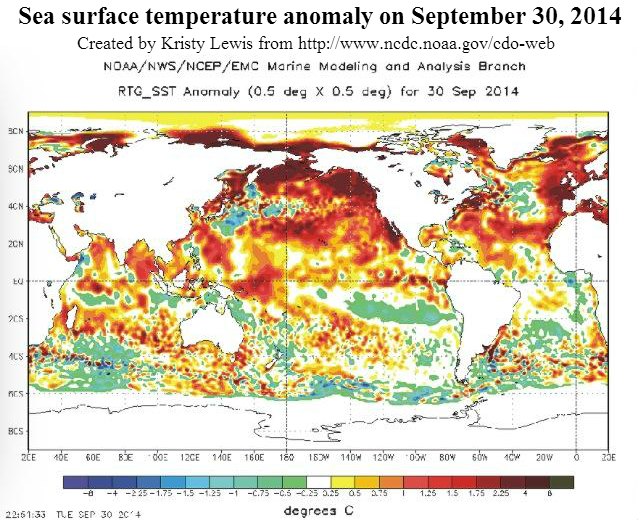The image below gives a world view, showing SST anomalies at the top end of the scale in the Laptev Sea.
The top end of the scale on the above image is 5ºC (or 9ºF).
The visualizations above and below uses a much higher scale. Even this higher-end scale doesn't appear to fully capture the dire situation we are in.
Above image shows warm water entering the Arctic Ocean through the Bering Strait and from the North Atlantic. For months to come, the Gulf Stream will keep pushing warm water into the Arctic Ocean (i.e. water that is warmer than the water in the Arctic Ocean). It takes some time (i.e. months) for the warm water from the north Atlantic to arrive in the Arctic Ocean.
Last year, methane emissions started to become huge in October and this lasted for some six months. The image below, from an earlier post, shows methane eruptions from the seafloor of the Arctic Ocean on October 16/17, 2013.
The image below, from another earlier post, shows methane eruptions from the seafloor of the Arctic Ocean on October 31, 2013.
The image below, from yet another earlier post, shows methane levels as high as 2662 parts per billion on November 9, 2013.
This year, there is even more ocean heat present, especially in the north Atlantic and the north Pacific. On September 29, 2014, methane levels as high as 2641 parts per billion were recorded and it looks like worse is yet to come.
The video below, Sea floor methane hydrate climate hazard, is an extract produced by Peter Carter from a presentation by Miriam Kastner, uploaded 7 August 2008 at Youtube.
The situation is dire and calls for comprehensive and effective action, as discussed at the Climate Plan blog.
Post by Sam Carana.








3 comments:
It is dire, can man get with the program?
Things have advanced relative to Earth losing her place within HZ. Habitable Zone for liquid water to exist.
To say the least, options are slim to actually arrest and reverse the process at this point.
There are smarter people than me who want to prove that intelligence extinction can be beaten in the universe.
http://www.examiner.com/article/climate-change-and-the-methane-crisis-q-a-with-harold-hensel
Here is a video about Permian extinction and its connection to global warming and release of methane hydrates. But all that took 100.000 years. Are we expecting that to be quicker this time??
https://www.youtube.com/watch?v=Ngt1N7Ftvaw
Post a Comment